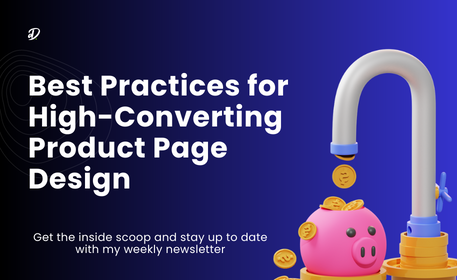Introduction
In the competitive world of e-commerce, a high-converting product page is crucial for success. A well-designed product page not only showcases your offerings but also persuades visitors to make a purchase. Whether you run a small online store or manage a large e-commerce platform, implementing the best practices for product page design can significantly impact your bottom line.
In this article, we will explore the key elements of an effective product page design and provide expert insights to help you create high-converting pages that leave a lasting impression on your customers.
Best Practices for High-Converting Product Page Design
1. Understand Your Target Audience
To create a product page that resonates with your customers, you must first understand their preferences, pain points, and buying behavior. Conduct thorough market research, analyze customer feedback, and leverage data analytics to gain valuable insights into your target audience.
2. Craft Compelling Product Titles
An attention-grabbing product title is the first step to attract potential buyers. Incorporate your primary keyword and use power words that evoke emotions. Keep the title concise and descriptive, highlighting the product’s unique selling proposition (USP).
3. Engaging Product Descriptions
Write detailed and persuasive product descriptions that emphasize the benefits and features. Use storytelling techniques to create a connection with the reader and address any potential concerns they may have. Incorporate LSI keywords naturally to improve search engine visibility.

4. High-Quality Product Images and Videos
Visual content is powerful in convincing customers to make a purchase. Include high-resolution images from multiple angles, and if applicable, include product demonstration videos. Allow users to zoom in on images for a closer look, ensuring they have a clear understanding of what they’re buying.
5. Intuitive Website Navigation
A clutter-free and easy-to-navigate website enhances the user experience. Ensure that your product pages are accessible from the homepage with a clear and logical menu structure. Implement breadcrumb navigation to help users find their way back to previous pages effortlessly.
6. Clear Call-to-Action (CTA)
Place a prominent and visually appealing CTA button that encourages users to take action. Use action-oriented words such as “Buy Now,” “Add to Cart,” or “Get Started” to prompt conversions. Ensure the button stands out from the rest of the page and is easily clickable on both desktop and mobile devices.
7. Build Trust with Customer Reviews
Positive customer reviews and testimonials build trust and credibility. Display genuine reviews prominently on your product pages. Respond to negative reviews with empathy and address any concerns to show that you value customer feedback.
8. Optimize Page Loading Speed
Fast-loading pages are essential for reducing bounce rates and improving SEO rankings. Compress images, leverage browser caching, and use content delivery networks (CDNs) to optimize page loading speed.
9. Mobile-Responsive Design
Given the rise in mobile users, having a mobile-responsive product page is non-negotiable. Ensure that your product pages adapt seamlessly to various screen sizes and devices.
10. Implement Social Proof
Showcase social proof elements, such as the number of products sold, subscribers, or followers, to create a sense of popularity and trust. Incorporate social media sharing buttons to encourage customers to share your products with their networks.
11. Highlight Limited-Time Offers and Discounts
Urgency and scarcity drive conversions. Highlight limited-time offers, discounts, and sales promotions to create a fear of missing out (FOMO) among potential buyers.
12. Provide Multiple Payment Options
Offering diverse payment methods caters to a broader audience. Ensure secure payment gateways and display accepted payment options on the product page.
13. Cross-Sell and Upsell Opportunities
Suggest related products or product bundles that complement the item being viewed. Upsell premium versions or add-ons to increase the average order value.

14. Offer Hassle-Free Returns and Refunds
A transparent and customer-friendly return policy can remove purchase barriers. Clearly state your return and refund policy on the product page to instill confidence in hesitant buyers.
15. Utilize Live Chat Support
Integrate a live chat feature to assist customers in real-time. Prompt responses to queries can improve customer satisfaction and encourage conversions.
16. A/B Testing for Continuous Optimization
Regularly conduct A/B tests to experiment with different product page elements. Analyze the results to identify what resonates best with your audience and refine your design accordingly.
17. Leverage Social Media and Influencers
Collaborate with influencers to promote your products and create user-generated content (UGC). Social media is a powerful tool to drive traffic to your product pages.
18. Address Security Concerns
Display trust badges and security certifications to reassure customers about the safety of their personal information during transactions.
19. Optimize for Voice Search
As voice search gains popularity, optimize your product pages for voice queries by using natural language and conversational keywords.
20. Offer Guest Checkout
Streamline the checkout process by allowing guest checkout, reducing cart abandonment rates.
21. Personalization for a Tailored Experience
Utilize data-driven personalization to offer relevant product recommendations based on a customer’s browsing history and preferences.
22. Implement Live Product Demos
Host live product demos or webinars to showcase your products in action and answer customer queries in real-time.
23. Integrate User-Generated Content (UGC)
Feature UGC, such as customer photos and testimonials, to build authenticity and foster a sense of community around your brand.
24. Optimize for Local Search
If you have physical stores, optimize your product pages for local SEO to attract nearby customers.
25. Measure and Analyze Performance
Utilize web analytics tools to track product page performance, conversion rates, and user behavior. Use data-driven insights to make informed decisions and further improve your product pages.

Conclusion
Creating high-converting product pages requires a thoughtful combination of design, content, and user experience optimization. By implementing the best practices outlined in this article, you can significantly enhance your e-commerce website’s performance, boost sales, and create a memorable shopping experience for your customers.
Remember to constantly analyze data, conduct A/B tests, and stay updated with the latest industry trends to stay ahead of the competition. By prioritizing your customers’ needs and preferences, you’ll build a loyal customer base and drive long-term success for your e-commerce business.
So, start implementing these best practices and watch your product pages transform into powerful conversion machines, driving growth and revenue for your business.






